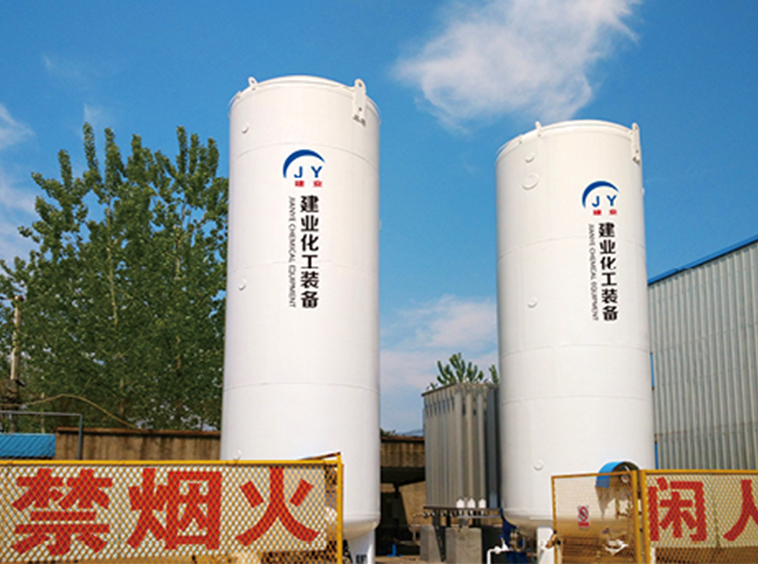Name: Jiangsu Jianye Chemical Equipment Co., Ltd.
Contact: Liu Yong
Phone:0512-58370568
Mobile:13806225925
Fax:0512-58371568
Mailbox:ly925@jylng.cn
Address: Sanjiali Road, Nansha, Jingang Town, Zhangjiagang City
Website:en.jylng.cn
Unloading process of cryogenic storage tanks:
1. The monitoring tanker is reversed according to the indication plate. After the vehicle is finished, the indicator plate is placed in front of the vehicle to prevent the vehicle from starting when the vehicle is unloaded.
2. Close the inlet and outlet manifold connection valve before unloading and close the dumper return valve.
3. Open the upper and lower inlet valves of the target cryogenic tank to determine the inlet manifold pressure.
4. Connect the unloading hose and grounding wire, check the opening and closing state of the unloading platform valve, ensure that the unloading pipeline and the boosting pipeline are unblocked, and the bypass is closed.
5. Open the purge valve and the tanker venting valve, and purge the unloading hose with nitrogen.
6. After purging, close the nitrogen purge valve, and slowly open the unloading supercharger liquid phase pipe valve to pre-cool the pipeline (the pre-cooling of the inlet flange of the supercharger is regarded as pre-cooling, the time is about 10 minutes). After that, the supercharger pipeline valve is fully opened to pressurize the tanker to 0.7 Mpa.

7. Slowly open the inlet gate valve to pre-cool the pipeline (the frosting of the inlet pipe flange is considered as pre-cooling, the time is about 10 minutes). After that, the liquid inlet valve is fully opened, and the pressure and pressure difference of the inlet line are guaranteed to be above 0.2 Mpa, but the inlet pipe pressure must not exceed 0.65 Mpa.
8. During the unloading process, when the tank LNG liquid level is above 400mm, the tanker pressure should be maintained at around 0.7 Mpa.
9. When the LNG liquid level of the tanker approaches zero, the unloading of the tank is completed when the tank LNG pressure is equal to the target tank LNG pressure.
10. After discharging the residual gas in the tank to the BOG buffer tank, close the tank liquid phase and gas phase valve, open the unloading station inlet pipe and the BOG pipe communication valve, close the BOG to the buffer tank valve, close the inlet gate valve, and open the vent valve. After the low pressure residual gas of the inlet pipe and the BOG pipe is discharged through the unloading vent line, the hose and the grounding wire are disassembled. Retract the vehicle sign.
11. Close the low temperature storage tank inlet valve, open the inlet and outlet communication valves, and unload the return valve.
12. When unloading the truck, the manual tank BOG valve can be opened to speed up the unloading speed, or the booster circuit of the tank can be connected with the booster circuit of the tank to reduce the pressure inside the tank, so as to increase the unloading speed.
13. Confirm that the inlet pipe is in a cold state. Otherwise, the inlet pipe (LNG storage tank or tanker feed) should be used to pre-cool the inlet pipe.
14. The monitoring tanker reverses according to the indication position. After the vehicle is finished, the indicator board is placed in front of the vehicle to prevent the vehicle from starting when the vehicle is unloaded.
15. Close the inlet and outlet manifold connection valve before unloading and close the dumper return valve.
16. Open the upper and lower inlet valves of the target cryogenic tank to determine the inlet manifold pressure.
17. Connect the unloading hose and grounding wire, check the opening and closing status of the unloading station valve, ensure that the unloading pipeline and the boosting pipeline are unblocked, and the bypass is closed.
18. Open the purge valve and the tank line venting valve, and purge the unloading hose with nitrogen.
19. After purging, close the nitrogen purge valve and slowly open the unloading supercharger liquid phase valve to pre-cool the pipeline (the pre-cooling of the inlet flange of the supercharger is considered as pre-cooling, the time is about 10 minutes). After that, the supercharger pipeline valve is fully opened to pressurize the tanker to 0.7 Mpa.